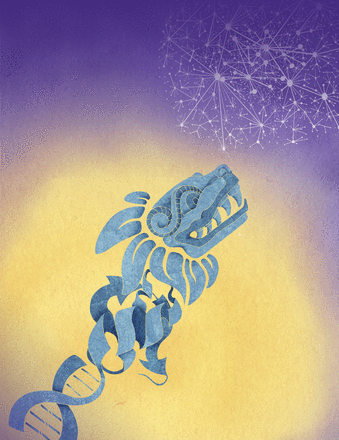Check out the January issue of GENETICS by looking at the highlights or the full table of contents!
ISSUE HIGHLIGHTS
Improving metabolic health through precision dietetics in mice, pp.399–417
William T. Barrington, Phillip Wulfridge, Ann E. Wells, Carolina Mantilla Rojas, Selene Y. F Howe, Amie Perry, Kunjie Hua, Michael A. Pellizzon, Kasper D. Hansen, Brynn H. Voy, Brian J. Bennett, Daniel Pomp, Andrew P Feinberg, and David W. Threadgill
Barrington et al. examined the effect of four human diets (American, Mediterranean, Japanese, and Maasai/ketogenic) on metabolic health across four mouse strains. The American diet negatively impacted health to varying degrees in all strains compared to a standard rodent chow. One or more other diets yielded improved health in each strain, but no single diet improved health across all strains. If similar genetic-dependent diet responses exist in people, then a precision dietetics approach to dietary recommendations may provide better health outcomes than traditional universal recommendations.
The evolution of gene-specific transcriptional noise is driven by selection at the pathway level, pp. 173–189
Gustavo Valadares Barroso, Natasa Puzovic, and Julien Y. Dutheil
Gene expression is a noisy process: in constant environment and genotype, cell to cell variability occurs because of randomness of biochemical reactions at the molecular level. Expression noise is under natural selection; Barroso, Puzovic, and Dutheil study the selective forces at play and report that gene interactions within networks are the main driver of the evolution of expression noise. They propose that natural selection against noise at the pathway level generates differential selective pressure at the level of genes based on their position in the network.
Protein moonlighting revealed by noncatalytic phenotypes of yeast enzymes, pp. 419–431
Adriana Espinosa-Cantú, Diana Ascencio, Selene Herrera-Basurto, Jiewei Xu, Assen Roguev, Nevan J. Krogan, and Alexander DeLuna
An increasing number of multifunctional proteins are being identified, but it is still unclear to what extent proteins moonlight beyond their annotated molecular functions. Here, Espinosa-Cantú et al. focus on yeast biosynthetic metabolism to systematically test the null hypothesis that enzyme phenotypes depend solely on their annotated catalytic activity. Their study shows that enzyme-loss phenotypes, including genetic interactions, are often not driven by the loss of their annotated function, underscoring the moonlighting nature of cellular metabolism.
Isolation of aggressive behavior mutants in Drosophila using a screen for wing damage, pp. 273–282
Shaun M. Davis, Amanda L. Thomas, Lingzhi Liu, Ian M. Campbell, and Herman A. Dierick
Genetic screens have been extremely fruitful to identify mechanistic components in a broad range of biological processes. Aggressive behavior has largely been refractory to this type of analysis because the required is tedious and time consuming. Davis et al. discovered that group-housing aggressive flies leads to noticeable wing damage over time. They used this easy to score a wing damage phenotype and succeeded to isolate mutants with aggressive behavior. They characterized one of the mutants and found the causal mutation in a gene that regulates neuronal excitability.
Evidence for selection-by-environment but not genotype-by-environment interactions for fitness-related traits in a wild mammal population, pp. 349–364
Adam D. Hayward, Josephine M. Pemberton, Camillo Berenos, Alastair J. Wilson, Jill G. Pilkington, and Loeske E. B. Kruuk
To understand how organisms may adapt to environmental changes, it is necessary to determine how environmental conditions influence evolution in wild animals. Hayward et al. used twenty-five years of data collected from a wild population of Soay sheep to show how an important environmental variable, population density, influenced natural selection and genetic variation. Their results suggest that, while environmental conditions are important in shaping natural selection, their effect on the expression of genetic effects in wild populations is more limited.
Fitness costs and variation in transmission distortion associated with the abnormal chromosome 10 meiotic drive system in maize, pp. 297–305
David M. Higgins, Elizabeth G. Lowry, Lisa B. Kanizay, Philip W. Becraft, David W. Hall, and R. Kelly Dawe
The maize abnormal chromosome 10 (Ab10) meiotic drive system causes its own preferential transmission through females, yet it is found at low frequencies in natural populations. Higgins et al. help to explain this observation by revealing that Ab10 has significant deleterious effects in the homozygous state. Its selfish properties as a meiotic driver allow it to maintain a stable presence, but its negative effects on plant productivity at high frequencies set up an equilibrium where the chromosome is often observed—but never fixed—in maize.
Using separation-of-function mutagenesis to define the full spectrum of activities performed by the Est1 telomerase subunit in vivo, pp. 97–110
Johnathan W. Lubin, Timothy M. Tucey, and Victoria Lundblad
A leading objective in biology is to identify the complete set of activities performed by each gene. Identification of a comprehensive set of separation-of-function mutations for each gene is an under-utilized approach. The Lundblad laboratory developed a genetic strategy to facilitate the rapid identification of this particular category of mutations. When applied to theSaccharomyces cerevisiae EST1 gene, they identified four biochemically distinct functions, including a new regulatory activity, thus illustrating the effectiveness of this strategy even for well-studied proteins like Est1.
Assessing the relationship of ancient and modern populations, pp.383–398
Joshua G. Schraiber
Sequencing DNA from deceased individuals can inform whether the individuals that currently live in a location are descended from individuals that historically occupied that location. Schraiber developed a maximum likelihood framework for testing this hypothesis that accounts for the low coverage data and is robust to ascertainment in the modern population. Thus, it is ideally situated to be used in modern ancient DNA datasets, which often sequence individuals to low coverage on a panel of SNPs ascertained in a modern population. By examining a panel of ancient Europeans, he found that prehistoric Europe was characterized by local extinction.































